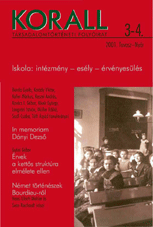Kisvárosi társadalom és gimnáziuma. Egy mezővárosi gimnázium helybeli diákjai a 19. század első felében
Small town society and its secondary school. The students of local originin the secondary school of a market-town in the first half of the 19th centur
Author(s): Gyula BendaSubject(s): History
Published by: KORALL Társadalomtörténeti Egyesület
Keywords: social history; social history of education; social composition of secondary school students; 19th century; Hungary; Keszthely; urban society and education
Summary/Abstract: As part of a social historical monograph the study tries to clarify the role of secondary education in the reproduction and mobility of a local society. First we examined the composition of secondary school students according to number, age and social origin, then concentrating on social origin we tried to define the significance of schooling in the process of social reproduction. We found that in addition to the expected rate of children of the intelligentsia and officials, the high rate of the sons of craftsmen among secondary school students was also characteristic in the first half of the 19th century. Carrying out the detailed analysis of the group of craftsmen occupational differences and their possible consequences were also taken into consideration. The analysis did not only rely on macro-statistical evidences of occupational differences but on the characteristic features of individual careers and generation relations as well. It was mainly for the craftsmen that the secondary school provided possibility of the acquisition of new or „modern" ways of thinking. It is also worth mentioning that the sons of smallholders and vine-growers (a very characteristic group of the local society) were rarely found among the students which means that mobility or „modernization" through education was not so important for this group.
Journal: Korall - Társadalomtörténeti folyóirat
- Issue Year: 2001
- Issue No: 3-4
- Page Range: 104-127
- Page Count: 24
- Language: Hungarian

